徐冬梅---模块10 Unit2导学
- 格式:doc
- 大小:156.50 KB
- 文档页数:16
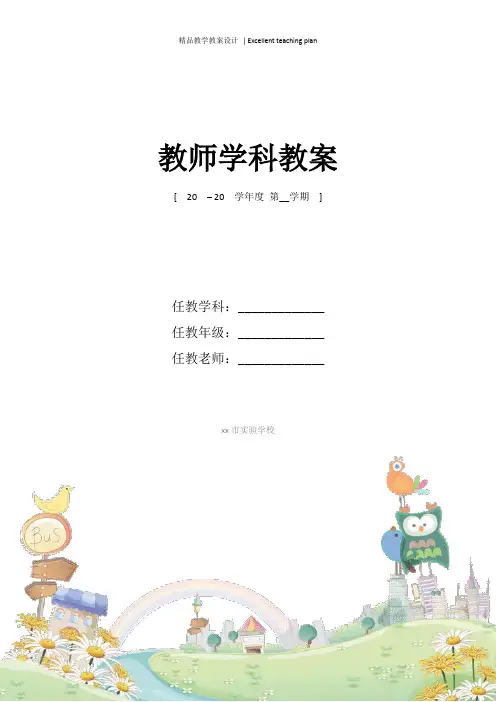
教师学科教案[ 20 – 20 学年度第__学期]任教学科:_____________任教年级:_____________任教老师:_____________xx市实验学校Module10 Unit2 第2课时教案一、教学内容外研版小学英语六年级上册第十模块第二单元第二课时:Unit 2 4. Listen and le arn to say. 6. Say “please”. 7. Write and talk.二、教学目标1. 大多数学生能够听、说、读、写短语: go straight on, turn right, turn left, excuse me, be quiet.2. 大多数学生能够听懂并用句型“Go straight on. Turn left/ right. Stop! Don’t go!”指示方向和路线,表达交通规则。
3. 能够运用所学的语言知识与同伴进行交流。
4. 注意句子的朗读技巧和句子的语音语调。
三、重点难点(一)重点:1.听、说、读、写短语: go straight on, turn right, turn left, excuse me, be quite. 2.学习句型: Go straight on. Turn left/right. Stop! Don’t go!(二)难点1. 用句型“Go straight on. Turn left/right. Stop! Don’t go!”指示方向和路线并表达交通规则相关的指令。
2. 祈使句的用法。
3. 如何在现实中运用所学的句型。
4. 注意句子的朗读技巧和句子的语音语调。
四、教学准备1. 单词卡片(可从优教平台下载“Module10 Unit2单词卡片集”直接使用)。
2. 音频(可从优教平台下载使用)。
3. PPT课件。
五、教学设计Step 1 Warm-up1. Stick the traffic signs and word cards of last lesson on the backboard and play a missing game to revise the new phrases of k lesson.2. Watch the flash and sing the song of Page 60 together.【设计思路】通过游戏和歌谣来复习上节课的旧知识,调动学生的学习积极性,提高英语学习兴趣。
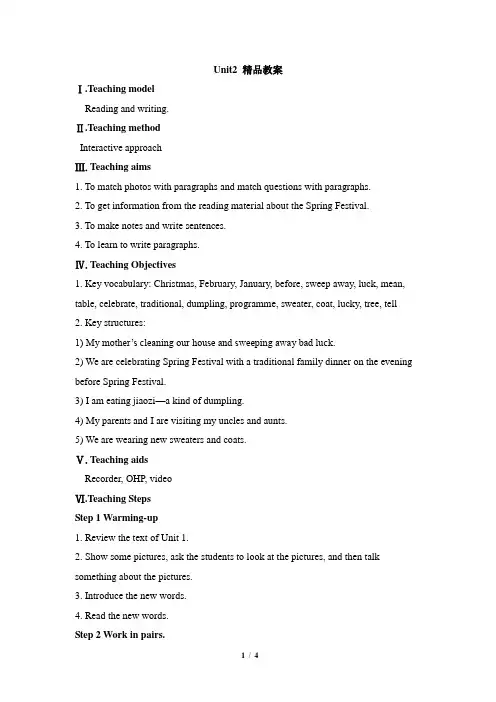
Unit2 精品教案Ⅰ.Teaching modelReading and writing.Ⅱ.Teaching methodInteractive approachⅢ.Teaching aims1. To match photos with paragraphs and match questions with paragraphs.2. To get information from the reading material about the Spring Festival.3. To make notes and write sentences.4. To learn to write paragraphs.Ⅳ.Teaching Objectives1. Key vocabulary: Christmas, February, January, before, sweep away, luck, mean, table, celebrate, traditional, dumpling, programme, sweater, coat, lucky, tree, tell2. Key structures:1) My mother’s cleaning our house and sweeping away bad luck.2) We are celebrating Spring Festival with a traditional family dinner on the evening before Spring Festival.3) I am eating jiaozi—a kind of dumpling.4) My parents and I are visiting my uncles and aunts.5) We are wearing new sweaters and coats.Ⅴ.Teaching aidsRecorder, OHP, videoⅥ.Teaching StepsStep 1 Warming-up1. Review the text of Unit 1.2. Show some pictures, ask the students to look at the pictures, and then talk something about the pictures.3. Introduce the new words.4. Read the new words.Step 2 Work in pairs.1. Read through the example sentences in Activity 1.—What’s Li Shan’s mother doing?—She’s cleaning the house.2. Look at the pictures and talk about what’s happening.Step 3 Read the passage and match the paragraphs with the pictures in Activity1.1. Read the passage and match the paragraphs with the pictures in Activity1.2. Check with a partner.3. Call back the answers from the whole class.Step 4 Reading.1. Play the recording.2. Ask the students to read through the passage.3. Complete the passage with the correct words and expression from the box in Activity 3.4. Check with a partner.5. Call back the answers from the whole class.6. Read the passage together.7. Learning to learnStep 5 Writing and speaking.1. Look at the notes about Christmas in Britain.2. Match the notes with the headings.3. Call back the answers from the whole class.Keys: Getting ready: a, ePresents: c, dTraditional things on Christmas Day: b, c, d, f, g, h4. Read the phrases together.Step 6 Writing1.Write sentences with the notes in Activity 4.Join two notes and write one sentences with and.2. Choose one of the headings in Activity 4 and write about Christmas in Britain. Step 7 Do exercises:单词拼写1. We are _________ (打扫) the wall together.2. It ____________ (意味着) happening.3. There are lots of ____________ (饺子) on the plate.4. _____________ (每个人) has his own problems.Keys: 1. sweeping 2. means 3. dumplings 4. Everyone完成句子。
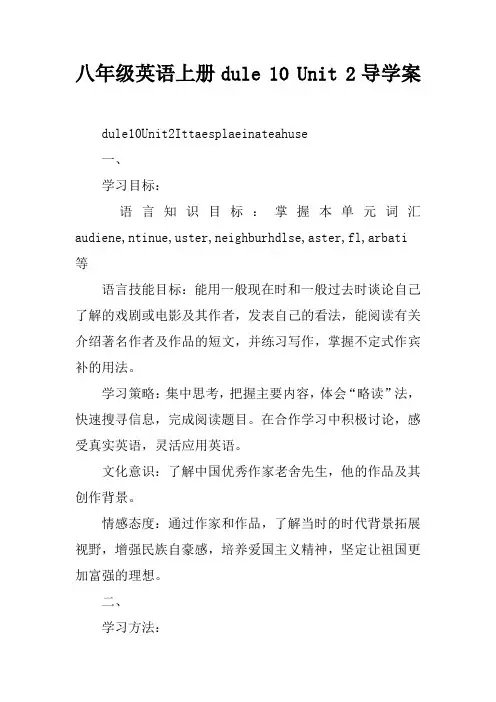
八年级英语上册dule 10 Unit 2导学案dule10Unit2Ittaesplaeinateahuse一、学习目标:语言知识目标:掌握本单元词汇audiene,ntinue,uster,neighburhdlse,aster,fl,arbati 等语言技能目标:能用一般现在时和一般过去时谈论自己了解的戏剧或电影及其作者,发表自己的看法,能阅读有关介绍著名作者及作品的短文,并练习写作,掌握不定式作宾补的用法。
学习策略:集中思考,把握主要内容,体会“略读”法,快速搜寻信息,完成阅读题目。
在合作学习中积极讨论,感受真实英语,灵活应用英语。
文化意识:了解中国优秀作家老舍先生,他的作品及其创作背景。
情感态度:通过作家和作品,了解当时的时代背景拓展视野,增强民族自豪感,培养爱国主义精神,坚定让祖国更加富强的理想。
二、学习方法:采用prehendinginntext和siing的阅读策略,利用幻灯片或制作来展开堂教学,pairr的问答试口语交际活动或小组活动,谈论戏剧或电影及其作者,发表自己看法,以达到综合运用语言的目的。
三、学习过程:Step1aring-upT:IlieplasandfilsDulieplasrfils?Ss:es!T:,vergdIanttnhnsaltabutplasrfils,sIillastquestinaf teruseethepiture“hat’sthenaefthepla?Andhat’stheriter’snae?”Step2Input(1)教师将活动2的词汇整理成简单的文概述中,并以打乱的顺于给出这些词汇的英文释义,让学生可以在图片资料形成的印象后,在相关短文中体会词汇含义,如有困难也可参看英文释义,完成Ativit2。
材料如下:Theplashstheaudienelifeinhinabeteen1898and194tThest rstartsin1898,ntinuesin1916,andfinall,itbringstheau dienetheendftheAnti-apanesearIttaesplainateahuseinldBeiingandittellsusthestrfangLifa---theteahuse’snerandhisustersTheseetheteahuseastheenterftheneigh burbdAfterthear,anglsestheteahuseandhedies ApartfatnBtstartdingsethingagainafterstppingfightingbeteenuntriesDthappenEapersnbuingthingsFpepleathingaplarfil(2)编写出6道词汇填空题,巩固新词汇的学习效果ARbrings_______intanderfulrldpeplehtater7hat_________________thilastnight?8TeahusetellsusthestrfangLifaandhis____________ 9Sheliestlistent_________usi0Ilie____________allfthesubets二动词应用1Reeber____________urfriendapstard2Idn’tnh___________aflashard?anutelle?3Hisfatherhasdeided___________arundtherld4eenttthetheatre___________aplaLaShe__________Teahusein1976________uever_________tLndn?es,tie7Ittthetears__________thenebridge8Helearned__________thepiantearsag9Thestr_____________plaeduringtheAnti-apanesear 0There___________greathangesinthelasttenearsStep6Her介绍你喜欢的电影(包括名字,故事情节,主角,精彩部分等)。
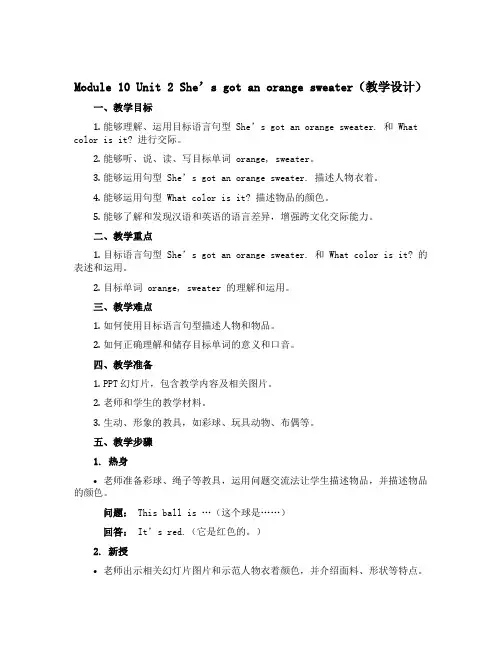
Module 10 Unit 2 She’s got an orange sweater(教学设计)一、教学目标1.能够理解、运用目标语言句型She’s got an orange sweater. 和 What color is it? 进行交际。
2.能够听、说、读、写目标单词 orange, sweater。
3.能够运用句型She’s got an orange sweater. 描述人物衣着。
4.能够运用句型 What color is it? 描述物品的颜色。
5.能够了解和发现汉语和英语的语言差异,增强跨文化交际能力。
二、教学重点1.目标语言句型She’s got an orange sweater. 和 What color is it? 的表述和运用。
2.目标单词 orange, sweater 的理解和运用。
三、教学难点1.如何使用目标语言句型描述人物和物品。
2.如何正确理解和储存目标单词的意义和口音。
四、教学准备1.PPT幻灯片,包含教学内容及相关图片。
2.老师和学生的教学材料。
3.生动、形象的教具,如彩球、玩具动物、布偶等。
五、教学步骤1. 热身•老师准备彩球、绳子等教具,运用问题交流法让学生描述物品,并描述物品的颜色。
问题:This ball is …(这个球是……)回答:It’s red.(它是红色的。
)2. 新授•老师出示相关幻灯片图片和示范人物衣着颜色,并介绍面料、形状等特点。
例:出示橙色毛衣,描述为“an orange sweater”,并模仿语音。
•老师教授目标语言句型She’s got an orange sweater. 和 What coloris it? 并注意发音和语调。
问题: What color is it?(它是什么颜色的?)回答1:It’s orange.(它是橙色的。
)回答2:She’s got an orange sweater.(她穿了一件橙色毛衣。
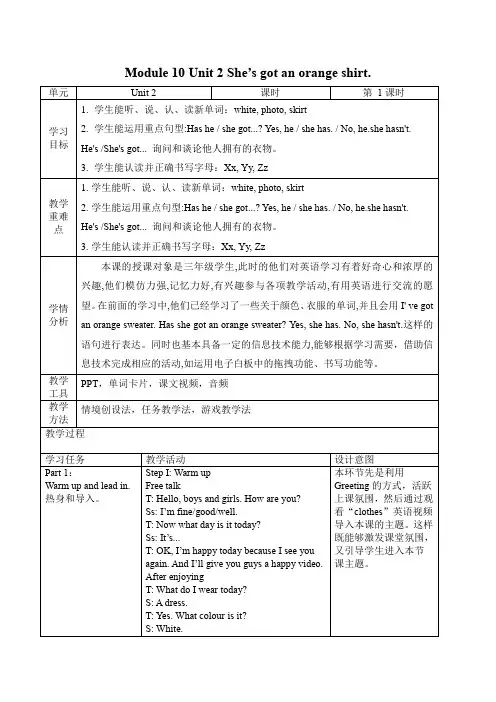
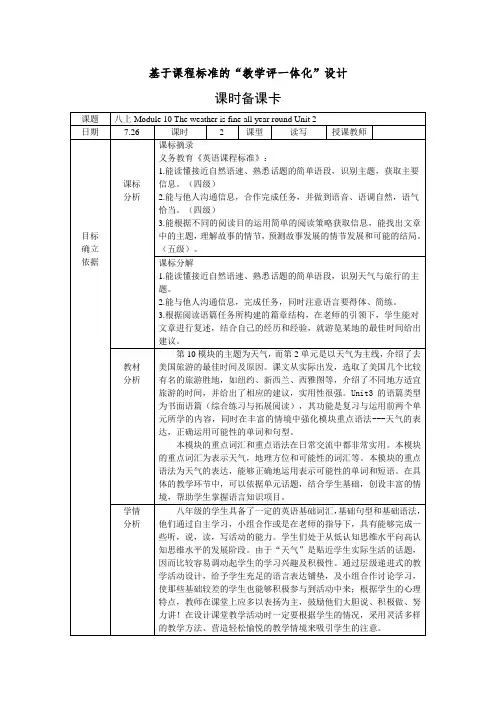
基于课程标准的“教学评一体化”设计课时备课卡教学目标通过本课时教学,让学生能够:1.熟读课文,能够根据课文框架复述文章。
2.掌握语言知识点:the best time to do,forget ,compare, had better do, turn...3.能够完成写作,详细描述到某地旅游的最佳时间,并使用because, so, but说明原因,给出建议。
评价任务评价标准1.熟读课文,根据课文框架复述文章。
(指向目标1)准确流利地读课文,语音语调准确;根据填空提示复述课文。
2.在活动与练习中理解并应用知识点及语法。
(指向目标2)灵活运用语言点和表示推测的情态动词、形容词和副词,准确翻译句子并完成练习。
3.用量规评价写作。
(指向目标3)根据任务单写作量规对写作进行指导与评价。
教学过程教学环节教学活动评价要点Step1 Read for revision Step1. 大声朗读并写出下列短语:1.到处旅行___________2.变成金黄色__________________3.一年到头___________4.游泳衣______________________5.最好做某事_________6.和……比较__________________7.有时,间或_________ 8.与…相比____________________Step2. 根据Act.2课文完成下列短文填空。
The US is a big country. So bring a ___ because you maywant to _____ around. New York and Washington DC are goodplaces ______. The best time to visit New English is in ______.The weather gets ______. You can take photos of the ______trees. The weather of California is fine all year ______. InSeattle, it _____ a lot. If you want to visit Alaska, you____ ____go in summer. In Texas, there are ______ from time to time. Sowhen is the best time to visit the US? ____ time you like.大声朗读短语能根据课文的大意完成短文填空。
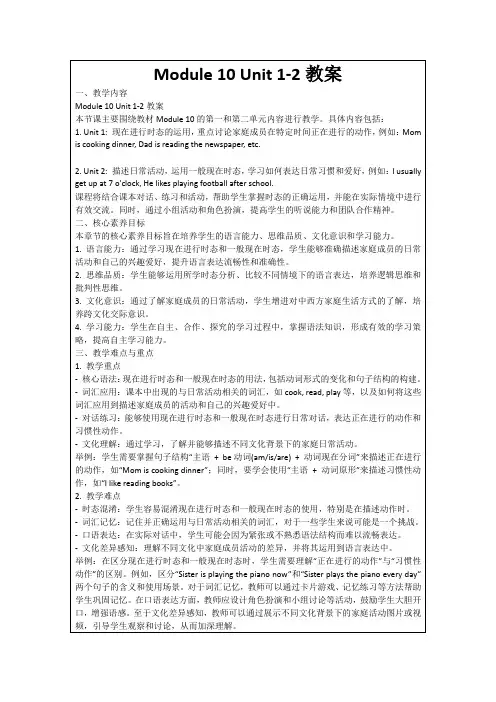
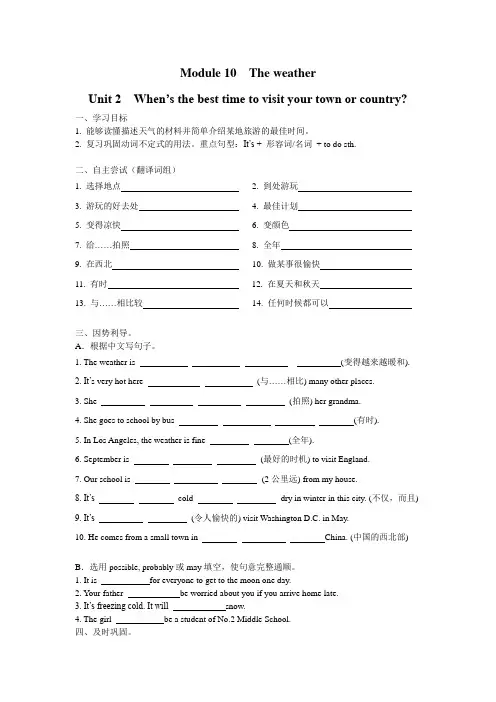
Module 10 The weatherUnit 2 When’s the best time to visit your town or country?一、学习目标1. 能够读懂描述天气的材料并简单介绍某地旅游的最佳时间。
2. 复习巩固动词不定式的用法。
重点句型:It’s + 形容词/名词+ to do sth.二、自主尝试(翻译词组)1. 选择地点2. 到处游玩3. 游玩的好去处4. 最佳计划5. 变得凉快6. 变颜色7. 给……拍照8. 全年9. 在西北10. 做某事很愉快11. 有时12. 在夏天和秋天13. 与……相比较14. 任何时候都可以三、因势利导。
A.根据中文写句子。
1. The weather is (变得越来越暖和).2. It’s very hot here (与……相比) many other places.3. She (拍照) her grandma.4. She goes to school by bus (有时).5. In Los Angeles, the weather is fine (全年).6. September is (最好的时机) to visit England.7. Our school is (2公里远) from my house.8. It’s cold dry in winter in this city. (不仅,而且)9. It’s (令人愉快的) visit Washington D.C. in May.10. He comes from a small town in China. (中国的西北部)B.选用possible, probably或may填空,使句意完整通顺。
1. It is for everyone to get to the moon one day.2. Your father be worried about you if you arrive home late.3. It’s freezing cold. It will snow.4. The girl be a student of No.2 Middle School.四、及时巩固。
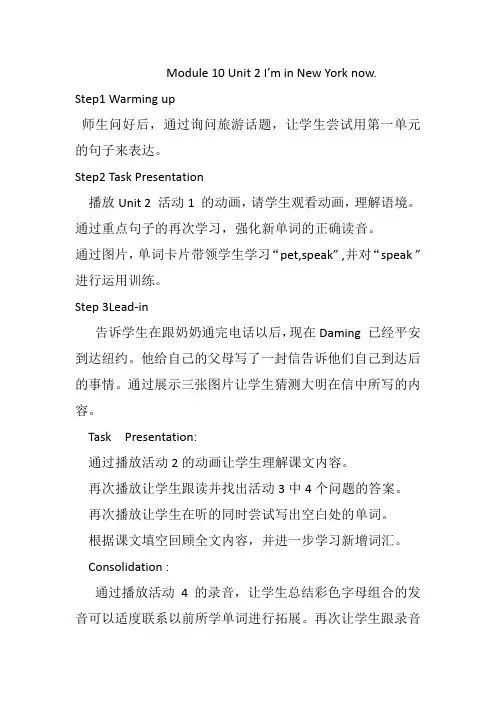
Module 10 Unit 2 I’m in New York now.Step1 Warming up师生问好后,通过询问旅游话题,让学生尝试用第一单元的句子来表达。
Step2 Task Presentation播放Unit 2 活动1 的动画,请学生观看动画,理解语境。
通过重点句子的再次学习,强化新单词的正确读音。
通过图片,单词卡片带领学生学习“pet,speak” ,并对“speak ”进行运用训练。
Step 3Lead-in告诉学生在跟奶奶通完电话以后,现在Daming 已经平安到达纽约。
他给自己的父母写了一封信告诉他们自己到达后的事情。
通过展示三张图片让学生猜测大明在信中所写的内容。
Task Presentation:通过播放活动2的动画让学生理解课文内容。
再次播放让学生跟读并找出活动3中4个问题的答案。
再次播放让学生在听的同时尝试写出空白处的单词。
根据课文填空回顾全文内容,并进一步学习新增词汇。
Consolidation :通过播放活动4的录音,让学生总结彩色字母组合的发音可以适度联系以前所学单词进行拓展。
再次让学生跟录音朗读体会发音规则。
通过播放活动5 的录音,让学生了解歌词大意及单词正确读音。
再通过播放活动5的动画让学生在听的同时掌握节奏并尝试跟唱。
教师可在听完后让学生及时标记书中要掌握的重点词汇。
通过让学生采取句子接龙方式熟练运用“be going to do”的句式,并进一步补充新的短语如“go swimming, go shopping, fly a kite, ride a bike 等”让学生在做中学,在学中做。
Summary:再次带领学生回顾活动2的内容,指出本节重点在于如何正确运用过去时表达自己的旅行经历。
Homework :1.在假期中相信很多同学都外出旅游了,希望大家将自己旅游过程中所拍摄的美好照片整理几张带来分享,并通过照片介绍一下自己在旅游景点的所见所闻比如:城市风貌、风土人情以及饮食或者地方特色等。
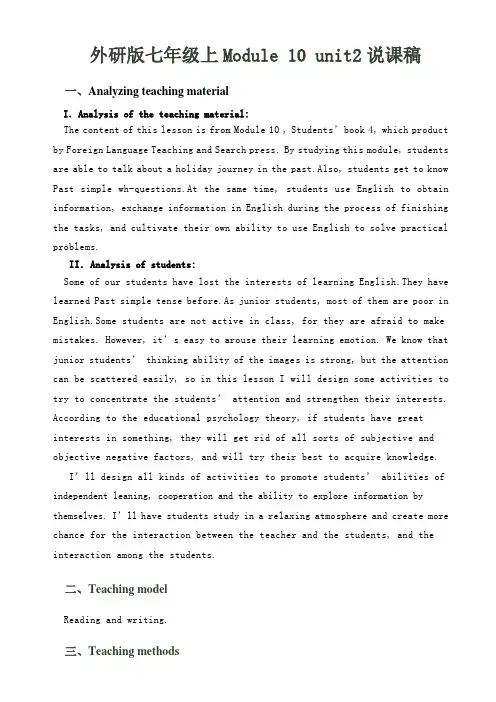
外研版七年级上Module 10 unit2说课稿一、Analyzing teaching materialI.Analysis of the teaching material:The content of this lesson is from Module 10 , Students’book 4, which product by Foreign Language Teaching and Search press. By studying this module, students are able to talk about a holiday journey in the past.Also, students get to know Past simple wh-questions.At the same time, students use English to obtain information, exchange information in English during the process of finishing the tasks, and cultivate their own ability to use English to solve practical problems.II.Analysis of students:Some of our students have lost the interests of learning English.They have learned Past simple tense before.As junior students, most of them are poor in English.Some students are not active in class, for they are afraid to make mistakes. However, it’s easy to arouse their learning emotion. We know that junior students’ thinking ability of the image s is strong, but the attention can be scattered easily, so in this lesson I will design some activities to try to concentrate the students’ attention and strengthen their interests. According to the educational psychology theory, if students have great interests in something, they will get rid of all sorts of subjective and objective negative factors, and will try their best to acquire knowledge.I’ll design all kinds of activities to promote students’ abilities of independent leaning, cooperation and the ability to explore information by themselves. I’ll have students study in a relaxing atmosphere and create more chance for the interaction between the teacher and the students, and the interaction among the students.二、Teaching modelReading and writing.三、Teaching methodsTop-down approach四、Teaching aims1. Listening and understand familiar topics ( a holiday journey ).2. Talking about personal experiences.3. Reading and finding specific information: completing a diary.4. Describing serial pictures and composing simple stories.五、Teaching ObjectivesKey vocabulary: arrive, relax, world-famous, French, sell, top, till, light, on, wonderful, palaceKey sentence: 1. I arrived in Paris by plane the day before yesterday.2. Aunt Joan and Uncle Peter met us at the airport.3. Yesterday we went to Louvre Museum.4. It has many world-famous works of art, such as the Mona Lisa.5. In the evening we had dinner in a French restaurant.6. This morning we took a walk.7. They sell such good fruit and vegetables.8. We waited till all the lights went on.六、Teaching proceduresStep 1 Warming-up1. Show some pictures.2. Review the text of Unit 1.3. Read the sentences after the teacher.Step 2 Learn new words.1. Show some pictures.2. Talk something about the pictures.3. Introduce the new words.4. Read the words after the teacher.Step 3 Reading.1. Play the recording and listen to the tape carefully.2. Ask the students to read through the passage.3. Read the email and check ( √) the true sentences.1) Betty arrived in Paris two days ago.2) She took a tour in the city the day before yesterday.3) They took the Paris underground today.4) They waited for three hours to go to the top of the Eiffel Tower.5) Tomorrow they are going to take a boat tour on the River Seine.4. Check with a partner.5. Call back the answers from the whole class.Keys: 1. √ 2. × 3. √ 4. × 5. √6. Read the text together.7. Learn how to write an email.Step 4 Complete the diary.1. Read through the text again.2. Work in pairs and complete the diary in Activity 2.3. Check with a partner.4. Call back the answers from the whole class.Keys: 1) •went to the Louvre Museum • had dinner in a French restaurant2) • took a walk •did some shopping • bought a present3) • went to the Eiffel TowerStep 5 Answer the questions.1. Answer the questions in Activity 3.1) Who met Betty at the airport?2) What did she see in the Louvre Museum?3) Where did she go this morning?4) When did they go to the Eiffel Tower?5) How did they get to Eiffel Tower?3. Ask the students to check with a partner.4. Call back the answers from the whole class.Keys:1. Her aunt and uncle met her at the airport.2. She saw the Mona Lisa.3. She went to shops and street markets.4. They went to the Eiffel Tower at about three o’clock.5. They went there by underground.Step 6 Complete the passage.1. Ask the students to read the words in the box in Activity 4.2. Ask the students to read through the passage in Activity 4.3. Complete the passage with the correct form of the words from the box.4. Check with a partner.5. Call back the answers from the whole class.Keys: 1. date 2.arrived 3. French 4. till 5. relaxed 6. top6. Read the passage together.Step 7 GrammarStep 8 HomeworkLook at the pictures. Write sentences about Daming and Lingling’s holiday.七、Blackboard design八、conclusion。
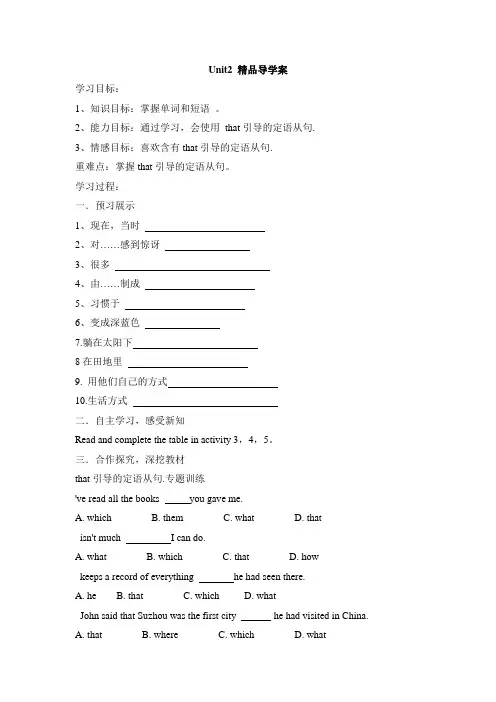
Unit2 精品导学案学习目标:1、知识目标:掌握单词和短语。
2、能力目标:通过学习,会使用that引导的定语从句.3、情感目标:喜欢含有that引导的定语从句.重难点:掌握that引导的定语从句。
学习过程:一.预习展示1、现在,当时2、对……感到惊讶3、很多4、由……制成5、习惯于6、变成深蓝色7.躺在太阳下8在田地里9. 用他们自己的方式10.生活方式二.自主学习,感受新知Read and complete the table in activity 3,4,5。
三.合作探究,深挖教材that引导的定语从句.专题训练've read all the books you gave me.A. whichB. themC. whatD. thatisn't much I can do.A. whatB. whichC. thatD. howkeeps a record of everything he had seen there.A. heB. thatC. whichD. whatJohn said that Suzhou was the first city ____ he had visited in China.A. thatB. whereC. whichD. whatTV play I watched last night is the best one I have watched this year.A. whichB. whatC. whoseD. thatSunday they reached Qingdao, a conference was to be held.A. whichB. thatC. whenD. wherethis the museum you visited the other dayA. thatB. whereC. in whichD. the one began to work in Beijing in the year _______ New China was founded. A. when B. that C. which D. whereis the very film I've long wished to see.A. whichB. thatC. whoD. whomis no difficulty can't be overcome in the world.A. thatB. whichC. whoD. whatis the person is standing at the gate of Beijing Tourism Tower?A. whoB. thatC. whichD. whomwas the supermarket I bought this kind of tin.A. hereB. thatC. whoD. whichis the last time I shall come here to help you.A. hatB. whichC. whenD. whathouse we live is not big.A. in thatB. whichC. n whichD. that 四.课堂运用,达标测试Ⅰ.单项选择。
模块10Unit2集体备课导学案(5课时)(译林牛津版高三英语选修十导学案)Module 10 Unit 2 People on the movePeriod 1-2 Word study(导学案)Learning aims(学习目标):1. Let students read the new words correctly and fluently.2. Get students to master some important words.Important points(学习重点): To master the usages of some important words.Learning procedures(学习过程):Step 1.Try to remember the new words as quickly as possible1.Read and recite new words and phrases in unit1. (方法引导:按音标正确读、背单词和短语)2.Word formation1. mobile (adj.)→ (n.)2. edition (n.)→ (v.) → (n.) 编辑3. age (n.& vi.) → (adj.)4. season (n.)→ (adj.)5. change (n.& v.)→ (adj.)6. retirement (n.)→ (vi.) → (adj.) 已退职的,已退休的→ (n.)退休者7. breakfast + lunch→ (n.) 早午餐8. host (v.)→ (n.) 主人→(n.)女主人9. physics (n.)→ (adj.) →(adv.)→ (n.) 物理学家内科医生外科医生10. biology (n.)→ (n.) 生物学家→ (adj.)11. analyse/ analyze(v.)→ (n.) → (adj.)12. adjust(vt.)→ (n.) → (adj.) 可调整的13. botany (n.)→ (adj.)14. suspect(n.)→ (v.) →(adj.) 不可信的15. terror (n.)→(n.)恐怖分子→(adj.)恐怖主义的→ (v.) 恫吓,威胁16. astronomy (n.) →(adj.) 天文的→ (n.) 天文学家1. bio- (构成名词、形容词或副词) 生物的;人生的→ 生物化学→生物技术2. astro- 星的;天体的;宇宙空间的→ 天体物理学3. tele- 远距离的;电视的;通过电话的→ 望远镜图文电视电话销售4. non- 不;非;无→ 不抽烟的人非暴力无政府的5. –ee→returnee _________ employee _________ interviewee_________ retiree _____6. –ship ⑴ 表状态、性质、品质→ ownership⑵ 表地位、资格、职位→ 公民资格教授职位⑶ 表技艺、技能→ musicianship⑷ 表集体(the group of)→ membershipAre you satisfied with what you’ve done?nguage Focus.(查字典探究下列单词和词组的用法)1. head2. exchange3. submit4. suspect5. account6. take to7. wander1. 1. head (n.&v.)head for ; be headed/heading for猜测并注意下列句中head的含义及用法⑴ She has been appointed to head the research team.⑵ He headed the class in the examination again.⑶ Come on. Let’s head the newspaper article with a title.⑷ Since he was the head of the family, his wish was acommand.⑸ He arranged his speech under four heads.2.exchange (vt.&n.)猜测下列各句中exchange及相关短语的含义⑴ Let’s have an exchange of views on the matter.⑵ Cultural exchanges between the two countries are on the increase.⑶ Would you like my golden watch in exchange for your camera?⑷ Where can I exchange dollars for RMB?⑸ I don’t want to sit here. May I exchange seats with you?⑹ We exchange ideas with our colleagu es almost every day.Cf. exchange / change / replace⑴ 动词exchange和change均可表示“交换”,有时可替用;但change还可以表示“改变”,强调一个人或一件东西从根本上或完全改变。
八年级英语上册Module 10 Unit 2导学案(2013新外研社)dule10 unit2导学案 No.32【学习目标】1、掌握Module10的5个单词及12个短语,能够读懂描述天气状况的语言材料。
2、通过阅读文章及小组合作,学会理解文章大意和提取细节信息的方法。
3、激情投入,专注高效;培养学习地理知识的愿望和兴趣,热爱自己的家乡,并能够就选择最佳时机来中国游玩给出建议。
【用法指导】 1、复习巩固unit2的单词。
2、默读课文,在文中勾画短语及疑难点。
【预习案】1、Words:本单元有几种词性的单词?请按照词性将它们归类,并写出相应的汉语意思。
_________________________________________________ _________________________________________________ _________________________________________________ _______________________________2、Reading praFast-reading:1、How maad(提及)assage?_________________________________________2、Read the passage fast and complable.Place Weather BvNew York Winter:New EnglandaliforniaAlaskaSummer:Winter:Careful-reading:Read paragraph 1, and answer quHow faUast coawest coast?__________________________________________2.Why should we bring a map?_________________________________________________ ______________Read paragraph 2, 3 and4, tell T or FIn New York and Washington Da lot of rain in winter. ( )2. In New England wweather gets coolgreen leaves start to turn browgold. ( )Because the weaaliforniau can gat aar, even in December. ( )Read paragraph 5 andbest answWhat’s the weatherluAlaska? ( )A. The days are long and warm.B. The days aand wa2. When should we go to visit Alaska? ( )A. In summerB. In wThere are alwaummer and autumn in Texas. Is that right? ( )AB. N’t.【探究案】1.阅读下面句子,并总结规律。
外研版英语八年级上册Module 10《The weather》(Unit 2)说课稿一. 教材分析《英语》(外研版)八年级上册Module 10《The weather》(Unit 2)的主要内容是关于天气的对话。
本节课的主要目的是让学生掌握与天气相关的词汇和表达方式,能够用英语进行简单的天气交流。
教材内容丰富,通过听、说、读、写等多种方式,让学生在实际语境中学习、实践和应用 weather-related expressions。
二. 学情分析八年级的学生已经掌握了基本的英语语法和词汇,具有一定的听说读写能力。
但是,对于一些天气相关的专业词汇和表达方式可能还比较陌生,因此需要在教学中引导学生掌握这些词汇和表达方式,提高他们的语言运用能力。
三. 说教学目标1.知识目标:让学生掌握与天气相关的词汇和表达方式,如:sunny,cloudy, rny, windy, hot, cold等。
2.能力目标:培养学生用英语进行天气交流的能力,提高他们的语言运用能力。
3.情感目标:通过本节课的学习,使学生更加关注天气,提高他们的生活品质。
四. 说教学重难点1.重点:天气相关词汇和表达方式的掌握。
2.难点:如何运用所学词汇和表达方式进行天气交流。
五. 说教学方法与手段1.交际法:通过情景模拟、角色扮演等方式,让学生在实际语境中学习、实践和应用 weather-related expressions。
2.任务型教学法:通过完成小组任务,培养学生合作学习的能力,提高他们的语言运用能力。
3.多媒体辅助教学:利用多媒体课件、视频等资源,丰富教学手段,激发学生的学习兴趣。
六. 说教学过程1.导入:以一首关于天气的歌曲《Weather forecast》导入新课,激发学生的学习兴趣。
2.呈现:通过展示天气预报的视频,引导学生关注天气,为新课学习做好铺垫。
3.新课:讲解天气相关词汇和表达方式,如:sunny, cloudy, rny, windy,hot, cold等。
作者VX:免费范文九年级英语上册module 10Unit 2导学稿九年级英语上册module 10unit 2导学稿module10unit 2learning aims: (学完后,如果你会,打个勾)1. i can read the new words2. i know the phrases: in the end persuade sb to do sth prefer a to b behave oneself ban sb from sth/doing sth课前预习:一、请熟读下面单词并标上中文意思。
improve __________________________sugar________________________________terrible______________________behave____________________________realise___________________________persuade____________________________kitchen_____________________educate______________________________weight_________________________typical_______________________________including_________________ diet________________________二、预习练习:(1) 1. junk food is b____ for your body. 2. it’s u_________ to eat some junk food.3. the newspapers w______ articles about him.4. how can you i__________ your diet?5. i am t_________. i want to have a rest.(2)1. we invited our teacher ___ dinner last sunday. a. have b.had c. to have2. ---____ people are there in your class? --- there are 50. a. how much b. how many c. how long3. ---i hope you are in good health. ---_____. a good luck b. thanks a lot c. yes, all right.4. _____ interesting story it was ! a. what an b. how c. how an5. he runs ____ faster than tom. a. a few b. a bit c. many随堂检测a. 1. he _______ to die ___ than steal. a. prefered, /b. preferred, ratherc. preferred, more2.do you think yao ming plays basketball as ______ as michael jordan?a. badb. badlyc. wonderfully3.--how much do you _______ ken folleit?-- only a little. but i know that a play of his was changed into chinese last year.a.think aboutb.know aboutc.hear about作者VX:免费范文。
课题: 英语(新标准)初二下册Module10 Unit2 It seemed that they were speaking to me in person.导学案(读写课)【学习目标】知识与技能:By the end of this class, you should be able to read the words correctly ; Put the sentences in the right order.过程与方法:1. Scanning, skipping, intensive reading and getting the relationshipbetween the sentences.2. Pair work and group work.情感态度与价值观:Success is no accident, but naturally effort!.----成功不是偶然,而是努力后的自然而然!【学习重难点】培养学生“明天成功都来源于今天的不懈努力”的人生观。
【学习过程】Part I Before-reading1.Warming-up :T: It’s……today, right ? Ss:------T: I got the information yesterday , so I am wearing the right clothes. Gettinginformation is very important, how can we get information now? Ss:------T: We also get information from the radio. There is a radio station in our school,……2.Prediction :Where is the passage from?(展示图片,预测内容)Part II While-reading1.Read the passage for the first time.在你认为可能选项后面打√号。
Unit 2 People on the moveReading Population movement in the USA Learning aims:1. To get a general understanding of the passage;2. To have an positive attitude towards population movement;3. To know how to match pictures with captions when reading newspapers or magazines. Learning procedures:●Detailed reading●Reading comprehensionRead the passage and choose the best answer1. What is the topic of the article?A. The population of people in the USA.B. The movement of people in the USA.C. The beautiful scenery of USA.D. The life people in the USA.2. Why are young people in the USA moving to cities?A. Cities are more exciting and have more job opportunities.B. Cities are more beautiful than the countryside.C. Young people don‟t like country life.D. There are no job opportunities in the countryside.3. Which of the following is NOT the reason for many people spending their later years in Florida?A. Wanting better health care.B. Looking for communities of older people.C. They like the climate there.D. They can get lots of money from the government.4. With the number of older Americans moving to Florida, many changes are made to cater to them. Which of the following is NOT the change?A. Ambulance response time has decreasedB. Many houses have bathrooms designed for elderly homeownersC. The communities that understand the needs of people.D. Big houses with the lower price.5. Why does Angela want to move to a big city?A. Because she wants to seek excitement in large cities.B. Because she wants to meet more people there.C. Because she enjoys the lifestyle of big cities.D. Because she wants to develop herself in her career.6. Which of the following is NOT the reason that attracts David and his wife to settle down in Florida?A. Getting good medical care.B. Meeting more people their age.C. Having a sunbath on the beach.D. Killing time in his own garden.PracticeFill in the blanks with the words given belowvariety; aged; slip; seasonal; on the move; ambition changeable ; year-round; experiencing; availablePeople are . For some people, the move is permanent and _____________.For some, it is .People give a of reasons. people want to move somewhere warm or where the weather is less ___________. They are tired of snow. Snow can turn into ice, which is easy to on. Whilecan drive young adults to big cities, even abroad where good job opportunities are __________.what‟s more, _____________ a new culture is another reason for their moving abroad.●Language points:1. The company is ________ a new way to market their latest products.A. looking outB. looking atC. looking upD. looking over2. Many houses have bathrooms _________ elderly homeowners.A. designing forB. to design forC. designed forD. are designed for3. The accident hasn‟t done any _______ damage.A. temporaryB. permanentC. compulsoryD. impermanent4. They only publish novels which _____ the mass market.A. refer toB. cater toC. stick toD. used to5. Even if they are on sale, these refrigerators are equal in price to, if not more expensive than, _____ at the other store.A. onesB. the othersC. thatD. the ones6. They are all very clever, but _______ of them could work the problem out.A. anyB. someC. noneD. neither7. Low-carbon lifestyle is of great benefit to improving the world environment. However, ____ can be enjoyed from it until you have a deep understanding of it.A. somethingB. everythingC. nothingD. anything8. For some of these people the move is permanent, but for others it is only for a few months of the year.(句型转换)→For some of these people the move is permanent, for others it is only .9. This group makes up over 17 percent of the state‟s population. (句型转换)→This group over 17 percent of the state‟s population.●Exercise一、选择合适的短语完成下列语句1. Recent pressure at work may his behavior.2. It to raise goats on the hills or mountains.3. The girls come from different backgrounds.4. Many developed countries, as well as some developing ones, areenvironmental protection issues to build a better future.5. The course beginners.6. So far, purchases of computers 50% of our sales this year.7. Although it was raining heavily, they still their destination without delay.8. I need a mobile phone as I‟m always.9. This restaurant is its polite service to the local people.10. The river, which is under the environmental protection, is many kinds of fish.二、WritingW rite a passage about …Living In The City‟ . Your own opinion should be included. (UsingRecently, our class have had a heated discussion about whether we should live in the city. The opinions are divided.Unit 2 People on the moveGrammar and usageLearning aims:1. To understand the element of a paragraph2. To grasp the skill of analyzing a paragraph by finding the element of a paragraphLearning procedures:①段落的基本要素段落是由三个基本组成部分组成:主题句、扩展句和结论句。